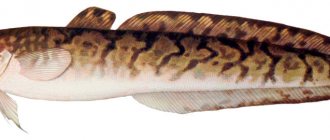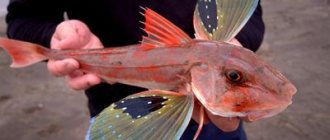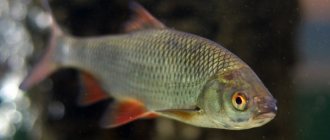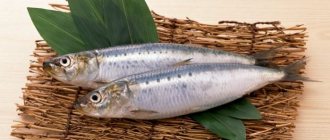Short description
Catfish is a predatory sea fish. Found in the Pacific, Atlantic and Arctic oceans. It lives both in the water column and at depths of up to 1700 meters; during hunting it can rise closer to the surface.
| Type: | Chordata |
| Class: | Ray-finned |
| Squad: | Scorpiformes |
| Family: | Zubatkov |
Because of its threatening appearance - large head and protruding teeth - it is sometimes called the “sea wolf” or “sea devil”. But the appearance of the “nibbler” is only an evolutionary feature characteristic of an inhabitant of the deep sea. Fish does not pose a danger to humans in water, and in gastronomic terms it is tasty and healthy.
Meaning for humans
Catfish fish is very tasty and, in addition, healthy for people. But catching this fish is quite difficult. It is because of this that people often hold competitions in catching it. To catch it, various tricks were invented, for example: they search for catfish using special underwater binoculars between the algae; for fishing they use very strong fishing rods with elongated hooks. Clam shells are used as bait.
The white meat of catfish is the most delicious part of the fish. It is very tender and fatty, has a slightly sweet taste, and most importantly, there is not a single bone in it. Many different recipes have been invented to prepare this fish.
Useful properties of fish
Eating this fish is very useful for people who have thyroid disorders, since its meat contains large amounts of omega-3 fatty acids. Doctors also recommend using it for those who have heart problems. Catfish meat helps remove cholesterol from the body and also strengthens the muscle tissue of the human body. In folk medicine, catfish is used during the rehabilitation period. By eating this fish, a person will be able to establish all metabolic processes occurring in the body, as well as normalize the water-salt balance and strengthen bones.
Harmful properties
Eating this fish is contraindicated for people susceptible to various allergies, since catfish is an extremely strong allergen. It is also not recommended to give fish to small children.
Scientists have proven that it is extremely contraindicated for pregnant women to consume catfish meat, as it has a negative effect on the child.
Interesting Facts:
- The lifespan of a catfish
is on average twelve years, but there have been cases when twenty-year-old representatives of this species were encountered. - The skin of this fish
is actively used for making shoes, handbags and book bindings.
Catfish is a family of marine fish of the Anarhichadiae order of perciformes, which live in the northern waters of the Atlantic and Pacific oceans, where the water temperature does not rise above 14 degrees. Off the coast of North America, from California to Alaska, catfish are found; Far Eastern catfish is common in the northwestern part of the Pacific Ocean; blue catfish (or "widow catfish") can be found in the North Atlantic Ocean; Striped catfish are caught in the Barents and White Seas, off the coast of England and Ireland (rarely in the Gulf of Finland).
It is no coincidence that this fish received its name - because of its strong, highly developed jaw with sharp, inwardly curved teeth and protruding fangs, like those of a wolf (by the way, in France, catfish is called “sea wolf”).
The characteristic shape of this fish's jaw and teeth is the result of the catfish's natural adaptation to its favorite foods: sea urchins, bivalves, snails and crabs.
Striped catfish (Anarhichas lupus) lives on a rocky bottom covered with algae and swims very close to the shore during spawning. Spawning occurs from November to February at a depth of 40 to 200 m, at the beginning of the period - in the northern regions, and at the end - in the southern regions.
Spotted catfish (Anarhichas minor) lives in Arctic waters.
The fishing grounds for catfish are the Barents Sea and the banks of Northern Norway. Currently, extensive scientific research is being conducted on the artificial breeding of catfish. Spotted catfish are more common in northern waters.
Handbags, wallets and belts are made from the dense skin of catfish with very small, as if recessed scales.
It is best to cook catfish by steaming or grilling, and if frying, then in batter or after boiling it in very salty water - otherwise the pieces of fish will literally “spread” over the frying pan. Hot or cold smoked catfish is a great appetizer.
Calorie content of catfish
The calorie content of raw Atlantic catfish is 96 kcal per 100 g of product. It is quite nutritious due to its high protein content. Boiled catfish contains 114 kcal per 100 g, and baked catfish contains 137 kcal. You should not overuse fried catfish, 100 g of which contains 209 kcal, as this can lead to extra pounds.
Appearance
Catfish are similar to eels and moray eels, but they are not related. She has an elongated body covered with small cycloid scales. When moving, it bends like a snake, aided by unpaired dorsal and anal fins.
The dorsal fin runs its entire length - from head to tail, the anal fin is 2 times shorter. There are no pelvic fins. The pectorals are huge, fan-shaped. Since catfish is not a fast fish, the caudal fin is poorly developed and small in size.
They range in length from 1.1 to 2.4 meters and weigh up to 29 kg.
A characteristic feature is a large head with powerful teeth in several rows and developed jaw muscles. This is not a sign of aggression, but only a consequence of adaptation to the bottom lifestyle and diet, consisting of those with strong protection in the form of a shell. The jaws are so strong that adults can bite the handle of a shovel with them.
What are the benefits of yellowtail and why is its meat prized in Japan? Read the link.
What kind of fish
There are five species of this fish in total - blue, striped, spotted, Far Eastern, eel. Each of them has its own characteristics, character, habitat, external characteristics and way of life. But the invariable characteristic feature of this aquatic inhabitant is a huge ugly head with large teeth concave inward. The appearance is terrifying.
In ancient times, people decorated their homes with dried heads with shark mouths; their task was to scare away uninvited guests. And the evil nature of the aquatic inhabitant gave rise to a lot of different myths, legends and stories about attacks on sailors. In appearance, the catfish is similar to a moray eel.
The catfish fish is a member of the Scorpionidae family. This is a close relative of perciformes. Scientists have found that it appeared in the Cenozoic era, about 60 million years ago. It differs from other representatives of aquatic fauna in its curved and high body, which gradually tapers towards the caudal fins. The top of the body is covered with dense scales. Their snout is rounded. The dorsal fins are long and consist of 78 soft rays. The caudal fin is rounded. The body length varies within two meters, the average body weight is 20 kg. Life expectancy in natural habitats is about 20 years.
Sexual maturity occurs after five years, the body length should be more than 70 centimeters. The female spawns from the second half of April to mid-autumn. During one spawning period, the female lays up to 40 thousand eggs. And the male will protect his offspring from the attacks of other predators.
Behavior and lifestyle
Catfish is a bottom-dwelling fish that leads a solitary, nocturnal lifestyle. During the day it is inactive, camouflaging itself on the bottom or in natural shelters - small crevices or among algae. At night it goes hunting, during which it can rise closer to the surface.
Young catfish move quite actively, while adults lead a more sedentary and bottom-dwelling lifestyle and prefer continental slopes. It has been noticed that the greater the depth it chooses for permanent residence, the less rapid its growth. Fish are most active during spring, summer and autumn.
Basically, spawning occurs in the summer, but can vary depending on the habitat - in the southern regions it can also occur in the winter months.
It feels quite comfortable in cold waters (at temperatures below 5), but in winter (when the temperature drops) it prefers to hibernate; during this period, it undergoes an annual change of teeth. It sinks to the bottom, choosing a greater depth than in summer, where the temperature is stable. The color becomes lighter and it may stop feeding for 1-1.5 months.
general characteristics
Catfish is a sea fish from the Perciformes. Mainly found in the north Atlantic Ocean, near Russia, Canada and even in the western Arctic. This cold-water fish feels comfortable in waters with temperatures below 5 degrees. Spends almost all of its time in ocean waters at depths from 400 to 1200 meters below sea level. It rises to the surface in search of food.
Catfish is a predatory fish. Its diet consists of smaller ocean inhabitants: sea urchins, crabs, starfish. At depths, their food becomes jellyfish and smaller fish. The peculiarity of these fish is their knife-sharp teeth, thanks to which they retain a dominant role in the world's oceans. And it was thanks to these terrifying teeth that the fish got its name. And its middle name is sea wolf: like this animal, the fish’s surprisingly developed jaw has protruding fangs and teeth turned inward.
Adult representatives can reach more than a meter in length and weigh more than a hundredweight. There are several types of catfish and they all differ in color. They can be dark gray to dark brown or even purple in color.
Types of catfish
Acne. Its habitat is the shores of North America: from Alaska to California.
Far Eastern. It is found in the Pacific Ocean, mainly in its northwestern part.
Blue. Found in the north Atlantic Ocean. Despite its name, its color can range from dark gray to dark brown and even purplish-purple. The pulp of these representatives is jelly-like.
Striped. Adults reach 22 kilograms and exceed one and a half meters in length. Distributed in the waters of the White and Barents Seas, near England and Ireland. Prefers rocky bottom. The fillet is quite firm. It differs from other species by dark vertical stripes on the sides.
Spotted (variegated). This one and a half meter giant is found in northern waters. The sides and fins are covered with dark spots. The pulp is quite dense
An adult catfish, so to speak, leads a sedentary lifestyle and moves along the bottom only in exceptional cases. But the young animals “plow” the ocean almost continuously.
During the spawning period, which for catfish occurs in the summer, females lay up to 30 thousand eggs. The rather large eggs of this fish settle on rocky bottom surfaces.
The lifespan of this fish is about 12 years. Having reached maturity (at 4-5 years of age), young catfish settle on the seabed and switch to the usual lifestyle for adult relatives.
Commercial fishing is one of the most important aspects of the global economy. Catfish are also not spared from fishing nets. Recently, in addition to the traditional fishing grounds - the Barents Sea and the coast of Northern Norway, catfish are bred artificially. But it is difficult to say that this northern fish is the most popular for the industry. Some people do not like its meat due to its excessive wateriness. Another reason for the low industrial popularity is the difficult-to-reach habitats of these predators. Getting a catch from deep water is too expensive. But this does not mean that there are no people in the world who want to eat her fillet. Moreover, cooks know the secrets of how to cook it correctly, and researchers claim that it is a healthy fish.
What does it eat?
The diet includes bottom and rock inhabitants:
- shellfish;
- echinoderms (brittle stars);
- ctenophores;
- crustaceans;
- jellyfish;
- small fish.
Catfish photo
Near the habitats of catfish you can find mountains of broken shells and shells. The structure of the jaws will allow it to tear prey from cameos with its fangs and grind shells or chitin with its internal teeth. But teeth wear out quickly, so they are replaced every year. During this period, catfish either do not eat at all, or are content with prey that does not have a strong shell.
In addition to shellfish, the diet is supplemented with:
- sea urchins;
- crabs;
- sea stars;
- snails
Underwater observations of the fish indicate its calm, non-aggressive nature. Her hunter is passive, which is explained by her low mobility. But if possible, she will not refuse to attack from cover, waiting for her prey rather than tracking it.
Cooking options
Catfish is a popular and sought-after product among gourmets. The tenderness and juiciness of its meat allows you to prepare a lot of delicious dishes. The carcass can be fried, dried, cooked in the oven, smoked, salted and boiled. This could be a delicious steak or a steamed diet dish. Adding this fish to a salad, appetizer, or pie is considered quite original. Let's look at the most popular recipes.
Sea wolf baked in foil
600 grams of fish need to be cleaned, washed, dried and divided into portions. Each piece should be placed on a separate piece of foil, seasoned with pepper, your favorite spices, and soy sauce. Place grated carrots and onion rings on top of the catfish. After this, the sea bass needs to be wrapped in foil and placed in an oven at 180 degrees for 30 minutes.
Fish in pots
600 grams of fish should be washed, peeled, dried and cut into pieces. One kilogram of potatoes must be peeled, washed and cut into cubes. Peel the carrots, wash and grate. Cut the washed and peeled onion into cubes. Pour vegetable oil into the pot, place the catfish, on top of which potatoes, carrots and onions are placed. The products should be salted, peppered, bay leaf and favorite seasonings added to them. Then pour some water and low-fat sour cream into the pot. You need to cook the delicacy for twenty-five minutes in the oven.
Catfish is a unique sea animal whose meat should be included in the diet. Reviews indicate that this fish goes well with vegetables, herbs, cereals, and mushrooms.
To learn how to make a catfish pie, watch the video below.
Natural enemies
For a large individual, the danger is:
- seals;
- sharks.
Caviar and juveniles become prey for all fish. This is why catfish protect their clutches. Moreover, males do this work.
Since some species are commercial, humans have also become its enemy. And if previously the indigenous peoples of the north, the Eskimos, had no influence on the numbers, industrial fishing has more than once brought local populations of catfish to the brink of extinction (in 2002 and 2012). The biggest danger to catfish in the modern world is uncontrolled fishing.
Reproduction and offspring
Catfish form monogamous pairs that remain permanently. Males fight for the female and the winner stays with the chosen one for the rest of his life. Fights between males are quite brutal, as evidenced by numerous scars on the head and body.
Despite the fact that each species has its own spawning characteristics, general patterns can be noted:
- caviar is glued into balls and deposited, as a rule, at depth;
- after laying, the males guard it for some time;
- egg development occurs slowly over several months;
- after hatching, the fry rise to the surface;
- For some time the fry feed on zooplankton and gradually try regular food;
- When they reach a size of about 7 cm, the juveniles sink to the bottom, and the fish begin to gradually switch to the main diet.
During the development of eggs and in the first year of life of the juveniles, most of the offspring die from natural enemies.
Interesting fact:
No one has seen clutches of blue catfish; moreover, the females that were caught in nets in the Barents Sea were without eggs. For this reason they are called "widows."
Commercial value
Catfish meat is prized in the market. But this is not a schooling fish and its catch is not the main thing for fishermen. However, when caught, it goes into processing. The catch is not carried out for all species, but mainly: striped, motley and blue.
Troll fishing for catfish
Striped fish are caught most of all in Russia and Iceland. The fishery is carried out by trawl (bag-like net) and longline (with hooks with bait) fishing method. The meat is firm and of good quality.
Longline fishing for catfish
Spotted fish are caught in the Barents Sea and off Greenland. Its meat is valued like striped meat, and its skin is traditionally used in the manufacture of various products - shoe uppers, bags, and in leather craft.
Is it possible for children
Feeding catfish is allowed from 3 years of age. This fish is not bony and rarely causes allergies. When prepared correctly and following the recommended standards, the product brings considerable benefits to the child:
- promotes mental activity;
- prevents the development of rickets;
- increases immunity;
- stimulates muscle growth.
Variegated or spotted catfish (Anarhichas minor)
Types of catfish with photos
There are 5 known species, each with its own anatomical, external and behavioral characteristics. The easiest way to distinguish is to check the color, a more difficult way is to compare the structure of the teeth - each species has its own.
Striped catfish
| Maximum length: | 1.5 meters |
| Maximum weight: | 24 kg |
| Habitat depth: | 20 - 450 meters |
| Nutrition: | mollusks, echinoderms, crustaceans, fish |
| Spawning period: | July - February |
Common Striped Catfish: Appearance
It is sometimes called the “common striped catfish” or “sand catfish.” It got its name because of the transverse stripes along the entire body. The most common type. It is a valuable commercial fish with dense meat of high quality. The main production occurs in the Barents and Northern Seas.
Where it is found:
- in the North Atlantic Ocean;
- in the Arctic Ocean.
In the seas:
- Barentsev;
- Norwegian;
- Severny;
- Bel;
- on the western part of the Baltic.
In waters around:
- Greenland;
- Spitsbergen;
- Labrador;
- Newfoundland;
- New Earth.
Photo of an ordinary striped catfish
They become sexually mature at the age of 5-10 years when their body length reaches 0.5 meters. Spawning takes place from mid-summer to February. The clutch contains from 600 to 40,000 eggs with a diameter of 5-6 mm. The protection of the clutch rests with the male.
Blue catfish
| Maximum length: | 1.8 meters |
| Maximum weight: | 20 kg |
| Habitat depth: | 100 – 1700 meters |
| Nutrition: | ctenophores, jellyfish, echinoderms, molluscs, crustaceans, fish |
| Spawning period: | April - October |
Blue catfish
Sometimes called "blue catfish". The body is longer than usual, but taller. The blue catfish differs from other species in that the vomerine row of teeth is shorter than the palatine ones. The color is more monotonous and dark with barely noticeable stripes or spots.
It becomes sexually mature at 5 years old, when the body length reaches 80 cm. It lays from 23,000 to 29,000 large eggs 6-7 mm. The male is also responsible for protecting the clutch.
Photo of blue catfish
Spreading:
- in the North Atlantic and Arctic oceans.
Found in the seas:
- Severny;
- Norwegian;
- Barentsev.
In waters around:
- Greenland;
- Spitsbergen;
- Labrador;
- Newfoundland;
- Novaya Zemlya;
- along the coast of Nova Scotia;
- off Sable Island.
Spotted catfish
| Maximum length: | 1.8 meters |
| Maximum weight: | 29 kg |
| Habitat depth: | 20 - 500 meters |
| Nutrition: | Mainly echinoderms (brittle stars, sea stars and urchins), few mollusks |
| Spawning period: | summer |
Spotted Catfish: Appearance
Sometimes called "spotted catfish." Many features resemble those of the striped and blue catfish, but the tuberculate teeth are less developed than those of the striped catfish. The vomer teeth do not protrude backward beyond the palatine teeth. The fry has wide black transverse stripes. When it begins to lead a bottom lifestyle, they break up into large spots.
Photo of spotted catfish
The habitats of spotted fish coincide with striped catfish, with the only difference being that in the north it is more common, and in the south less common than striped catfish. It is not found at all in the Baltic Sea, it is rarely found off Iceland, and off Norway it can be found north of Bergen. Unlike the striped catfish, it avoids thickets of plants, preferring rocky slopes.
Adults are 90-120 cm long and lay from 12,000 to 50,000 eggs with a diameter of 5-6 mm at depths of more than 100 meters.
Far Eastern catfish
| Maximum length: | 1.1 meters |
| Habitat depth: | meters |
| Nutrition: | mollusks, echinoderms, crustaceans, shells, fish |
| Spawning period: | summer |
Far Eastern catfish
It is distinguished by a large number of vertebrae (86-88), as well as rays in the anal fin. Young fish have dark stripes along their bodies. With age, they fragment into spots and gradually disappear. For this reason, adult individuals have a uniform, dark color.
They have strong tuberculate teeth and easily crush thick shells.
Photo of Far Eastern catfish
Where they live:
- from the coast of Asia from the island of Hokkaido to the eastern coast of Kamchatka;
- in the Chukchi Sea;
- in Norton Bay, Alaska;
- near the islands: Commander, Aleutian, Pribilof.
The species has no commercial significance, although the meat is valued among gourmets.
Eel catfish
| Maximum length: | 2.4 meters |
| Maximum weight: | 18.5 kg |
| Habitat depth: | mostly shallow water |
| Nutrition: | crustaceans, molluscs, echinoderms, rarely fish |
| Spawning period: | October-February |
Photo of the eel catfish
It is distinguished by its longer body, the presence of more rays in the dorsal fin (218-250) and a long anal fin with 180-233 rays. Unlike previous species, its caudal fin merges with the dorsal and anal fin. There is no air bubble.
Color ranges from gray to dark green. The body has dark spots that occur on the dorsal and pectoral fins. Prefers shallow water, rarely found at depths of more than 200 meters.
Main habitat:
- North Pacific.
Occurs:
- In the seas: Japan, Okhotsk and Bering;
- off the Aleutian Islands;
- north of Alaska and along the coast to Southern California.
They become sexually mature at 4 years of age. During spawning they form pairs. They lay up to 10,000 eggs. The clutch is guarded jointly by the female and the male.
River or sea
Catfish is a marine fish that lives in temperate and cold regions of the northern hemisphere. Lives on the continental shelf, adhering to its bottom layers at great depths. The natural habitat of the striped catfish is:
- western territory of the Baltic and North Seas;
- waters of the Faroe and Shetland Islands;
- northern territories of the Kola Peninsula;
- Norway, Iceland, Greenland;
- Motovsky and Kola bays;
- Bear Island;
- western territories of Spitsbergen;
- Atlantic shelf of North America;
- Barents and White Seas.
Spotted catfish are caught in the same place as common catfish. The exception is the Baltic Sea. The striped one is more common near the coastal areas of Iceland. It is found closer to continental shallows, but does not enter the coasts and areas with high vegetation. Likes to sit out at great depths. The blue one is found in the same place as the spotted one. But it actively moves to distant territories and lives at a kilometer depth. The Far Eastern one is found in the waters of Norton Bay, near the Aleutian and Commander Islands, near the island of Hokkaido, Kamchatka. The eel is found near the Pacific coast of North America, California and Alaska.
Chemical composition and calorie content
Catfish meat contains a large amount of proteins and fats, including Omega-3, and does not contain carbohydrates. There are vitamins A and B, as well as a whole range of chemical elements. Regular consumption of catfish in any form provides the human body with all the necessary elements.
Catfish meat is especially rich in:
- calcium and potassium;
- phosphorus (5th part of the daily norm of 100 g);
- sodium;
- zinc;
- selenium (more than 50% of the daily value of 100 g);
- iodine;
- cobalt;
- chrome.
The benefits of catfish
The majority of nutritionists are convinced that the meat of this representative of the living environment is perfectly digestible and is saturated with a variety of positive substances.
Useful qualities of the product:
- enrichment of cells with proteins involved in the structure of the body;
- removal of excess salt and the body, fight against edema;
- improving the immune system, increasing resistance to viruses and infectious diseases;
- stabilization of the functioning of the nervous system;
- proper functioning of the thyroid gland;
- active cholesterol removal;
- normalization of the cardiovascular system;
- establishing pH balance;
- memory improvement;
- normalization of pressure; burning excess fat.
Nutritional value per 100 g
Summary table of the nutritional value of mottled catfish contained in 100 grams of fillet. The data was collected based on the work of Skurikhin I.M. "Chemical composition of food products."
| Calorie content | 126 kcal |
| Squirrels | 19.6 g |
| Fats | 5.3 g |
| Carbohydrates | |
| Water | 74 g |
| Vitamins: | |
| A | 60 mcg |
| Retinol | 0.06 mg |
| Beta Carotene | 0.01 mg |
| IN 1 | 0.24 mg |
| AT 2 | 0.04 mg |
| AT 5 | 0.57 mg |
| AT 6 | 0.33 mg |
| AT 9 | 5 mcg |
| AT 12 | 2.03 mcg |
| C | 1.4 m |
| E | 0.4 mg |
| RR | 5.8 mg |
| Macronutrients: | |
| Potassium | 335 mg |
| Calcium | 30 mg |
| Magnesium | 35 mg |
| Sodium | 100 mg |
| Sulfur | 190 mg |
| Phosphorus | 180 mg |
| Chlorine | 165 mg |
| Microelements: | |
| Iron | 0.5 mg |
| Iodine | 50 mcg |
| Cobalt | 20 mcg |
| Manganese | 0.03 mg |
| Copper | 70 mcg |
| Molybdenum | 4 mcg |
| Nickel | 6 mcg |
| Selenium | 36.5 mcg |
| Fluorine | 430 mcg |
| Chromium | 55 mcg |
| Zinc | 0.6 mg |
| Polyunsaturated acids: | |
| Omega-3 fatty acids | 0.49 g |
| Omega-6 fatty acids | 0.15 g |
Contraindications and possible harm
It must be borne in mind that catfish, despite its usefulness, will not replace other products; it cannot be used as a main and daily food product. There are no harmful substances in it, but it has some limitations.
Catfish meat is contraindicated in the following cases:
- if you are allergic to fish;
- if the daily norm is exceeded for a long time (for adults 150-200 g, for children 60-150 g), negative consequences may appear - in such cases, many microelements can accumulate in the body;
— since catfish contains a lot of iodine, eating meat is contraindicated for people who have an excess of iodine in their bodies;
— due to the presence of a large amount of fat, if the functioning of the pancreas and liver is disrupted, the intake of catfish meat should be limited and excluded during an exacerbation.
It is important to know:
For a healthy lifestyle, it is recommended to include catfish meat in your diet no more than 2 times a week.
Useful properties of catfish fish
Due to the presence of fatty acids in the composition, cholesterol is removed from the body more quickly and has a beneficial effect on the cardiovascular system and brain. Due to the fact that the composition contains potassium in significant quantities, excess salts are removed.
Meat of all types of catfish has beneficial properties:
- Reduces the concentration of cholesterol in the body.
- Gives elasticity to blood vessels.
- Strengthens the immune system.
- Prevents the development of neuroses and depression.
- Improves vision, memory, brain activity.
- Normalizes the functioning of the thyroid gland.
- Reduces the likelihood of developing cancer.
- Activates the removal of salts from the body.
- Strengthens bone tissue.
- Takes care of hair and tightens skin.
- Normalizes hematopoiesis.
- Improves the functioning of the gastrointestinal tract.
If you consume fillet, you can normalize blood pressure, get rid of swelling and prevent the occurrence of atherosclerosis.
It is especially recommended to consume it:
- To old people;
- children;
- during pregnancy and lactation.
The main role is played by vitamins that help normalize well-being, improve immunity and ensure the required functioning of all organs and systems.
Since it contains vitamin D, it is possible to strengthen the skeletal system. In addition, it helps stabilize the nervous system, is responsible for blood clotting and helps the heart function normally. Vitamin PP prevents the development of atherosclerosis.
Since it contains iodine, it is very useful to consume catfish for those who have problems with the thyroid gland (hypothyroidism). Doctors often prescribe eating fish for those who suffer from diseases of the gastrointestinal tract, ischemia and hypertension.
Boiled fillet promotes the breakdown of fats, which has a beneficial effect on the figure. Thus, it is possible to remove toxins from the body and lose a few extra pounds.
Can pregnant and lactating women eat catfish?
Doctors have proven a negative effect on the fetal nervous system. Therefore, during pregnancy and lactation it is recommended to refrain from consuming the product. This fish is believed to be a source of heavy metals. The most dangerous for pregnant women is mercury, which causes mental and mental disorders in the child.
Can children eat catfish?
The child's body constantly requires vitamins, minerals, micro- and macroelements. Therefore, eating catfish will come in handy for children. In addition, it has been proven that fish meat improves memory and has a beneficial effect on brain function. Due to the content of useful substances in it, the child will strengthen bone and muscle tissue.
Another important point of including catfish in a child’s diet is the fact that regular consumption of fish meat strengthens the immune system, improves overall well-being, and saturates the body’s cells and tissues with essential substances.
How to choose and how long to store
If you are going to buy catfish in a store, you will be offered frozen or chilled (defrosted) fish. To choose the best, follow these simple recommendations:
- The best option is if the carcass is sold with the head. Look at the eyes - they should be clean and bulging. If there is cloudiness and the eyes are sunken, then the fish is stale.
- The gills should be pink-red, without mucus and odor.
- The scales of fresh fish are shiny and smooth to the touch, and fit tightly to the carcass.
- The belly and carcass must be free of mucus. The abdomen is not swollen. When you press on the carcass with your finger, the dimple should level out - this indicates the freshness of the fish.
- Fresh catfish fillet is elastic with a noble light shade.
Advice:
If it is not possible to buy live fish, then it is recommended to take chilled fish, in which case you can more accurately determine its freshness.
You can store chilled fish in the refrigerator for no more than a day. Frozen - no more than 2 months. Hot smoking - no more than 3 weeks, cold smoking - no more than 3 days.
Simple cooking methods, recipes and secrets
Catfish meat is tender, almost boneless, with low fat content. The taste is reminiscent of halibut or cod, so they can often be found as a substitute in recipes. It can be prepared by subjecting it to all types of heat treatment: in a frying pan, in the oven, in the microwave and on the grill, by boiling, and can be cooked using all methods of smoking.
General recommendations for cooking
- fish fillet may be watery, so that it does not fall apart during cooking, try to cut it into large pieces;
- you can soak it in salt water with lemon to make it stronger;
- when cooking, it is recommended to put it in boiling water, then the meat will not fall apart;
- if you don’t like the smell of boiled meat, then you can add lemon, dill or spices to the water;
- Catfish meat is a storehouse of useful substances; to preserve them during cooking, it is better to process it over high heat until crusty, and then simmer:
- For the same purpose, use batter effectively;
- or bake in foil;
- the meat has a good taste, do not overdo it with spices, a small amount of salt and pepper will be enough;
- After defrosting, the meat can be “dried” by wrapping it in a paper towel.
What products does it combine with?
The best ones are cabbage, carrots, beets, pickles, herbs, green vegetables, ghee. You can - tomatoes, butter, vegetable oil, pumpkin, eggplant, zucchini, rice, buckwheat, lemon.
Catfish is difficult to digest with - meat, poultry, lard, eggs, dairy products, cheeses, feta cheese, mushrooms, nuts, seeds, wheat, rye, oats, bread, peas, chickpeas, mung beans, beans, beans, lentils, potatoes.
Hot smoked catfish recipe
This is a very simple and fast cooking method.
- The fish is cut into large enough pieces across the vertebrae so that the pieces do not fall apart.
- Rub with salt and let it soak for at least 20 minutes. Salt should be applied to exposed areas of meat; there is no point in rubbing the skin with salt, it will not be absorbed.
- If you use fillet, then the pieces must be tied with threads, making a regular mesh.
- A small layer of sawdust is scattered at the bottom of the smokehouse - alder, apple or pear. The sawdust can be pre-moistened a little with water; it will smolder more evenly and longer.
- Prepared pieces of catfish are placed on a grate over sawdust.
- The smokehouse is closed and placed on coals; open fire is undesirable.
- The catfish takes about 40 minutes to prepare, depending on the thickness of the pieces.
- During cooking it will acquire a pleasant golden hue.
- You cannot eat smoked fish right away; you need to wait some time for the carcinogens that are formed during the smoking process to leave the meat.
Cold smoked catfish
This method is more labor-intensive and requires lengthy preparation, but this product has a longer shelf life, and the meat itself can be used in salads and for preparing other dishes.
- The fish is also cut into large enough pieces across the vertebrae so that the pieces can be conveniently hung.
- The pieces are rubbed with salt, placed in a container, sprinkled with salt on top and left for a day.
- Then you need to wash it and soak it in water for at least an hour to remove excess salt.
- The pieces must be tied with thread so that the fish does not fall apart during the smoking process.
- Next, they are placed in a ventilated place for a day so that they dry out a little and excess moisture is removed.
- Only after this can the fish be smoked with cold smoke (about 25 degrees). Smoking lasts a day; it is better to do this in a special smoking cabinet.
- Afterwards, the fish must be left to “finish” for another day.
- After removing the fish from the smokehouse, it is again left in a ventilated place for 1-2 days. During this time, it will dry out, excess moisture and the smell of smoke will disappear - the meat will return its taste with a light smoky aroma.
Catfish soup
You will need for 2 liters of water: 450 grams of catfish, 350 grams of potatoes, 100 grams of onions, a tablespoon of refined oil, 100 grams of carrots, ground black pepper, a little parsley, 40 grams of rice, a stalk of celery, fresh dill and salt.
- Pour 2 liters of water into a 3-liter saucepan, add half the carrots, onions, celery, and bring to a boil.
- Place the catfish in the boiling broth and cook over low heat for 15 minutes. Then remove the fish, remove the bones and strain the broth.
- Place rice, potatoes and remaining carrots in clean broth and bring to a boil. Add finely chopped onion. Cook until done.
- Add already cooked catfish, chopped herbs and seasonings to taste. Bring to a boil and turn off. The catfish soup is ready.
Use in cooking
Catfish is extremely widely used in cooking. The fish meat has a delicate and soft texture, is colored in a whitish tint, is not too fatty, and is practically boneless.
The taste of catfish is somewhat reminiscent of halibut or cod meat, but there are sweetish notes. Because of this similarity, it is possible to replace halibut and cod with catfish in recipes.
The described fish is perfect for frying and stewing in a frying pan, boiling in a saucepan, baking in the oven and on the grill of an air grill, electric grill or on a grill with coals, as well as for steaming in a double boiler, microwave and multicooker.
If you twist the fish fillet into minced meat (sometimes mixed with the meat of pollock, chum salmon, pink salmon, flounder, salmon), you can fry delicious and juicy cutlets. Catfish combines incomparably with foods such as tomatoes, sweet peppers, garlic, mussels, onions, parsley, and olive oil. Lemon juice will highlight the taste and smell of the finished dish.
A popular dish is catfish steak cooked in egg batter or breadcrumbs in a frying pan. It is worth clarifying that fish fillets should not be served with porridge, since the protein contained in the fish will be slowly absorbed. As a side dish, it is preferable to take vegetables (cabbage, potatoes, zucchini, carrots), as well as various varieties of rice.
Often, catfish is baked in the oven in pots, foil, a sleeve or baking paper along with cheese or mushrooms, supplemented with mayonnaise, cream or milk.
The fish is also complemented with sauces (soy, sour cream, cream or tomato). Sometimes, to make it more soft and nutritious, catfish is cooked in milk.
In addition, fish is added to salads, pies (baked in dough together with vegetables), omelettes, casseroles, fish soup (fish soup), and aspic is prepared from it along with seafood.
It is worth noting that catfish can be marinated to make barbecue over a fire, dried, salted, and hot and cold smoked.
In addition to meat, you can also take fish caviar. This product can be either salted or heat-treated.
Because of its surprisingly soft and delicate texture (some varieties of fish have a jelly-like fillet), many cooks are afraid to cook catfish because the fish's meat can fall apart, especially during frying.
However, there are a couple of ways to give the fish a firm consistency:
- Before frying the catfish, the fish must be boiled in very salty water. However, you should not cover the pan with a lid during frying, otherwise the fillet will still fall apart.
- You will need to dip the fish in a saline solution for thirty minutes. Afterwards, the fillet can be further cooked, but preferably with the skin on (to maintain the shape of the piece).
As you can see, there are many recipes that use such tasty fish as catfish.
Question answer
What is the difference between blue catfish and motley catfish?
- The body of the blue catfish is slightly taller, which makes it look larger.
- The blue color is monotonous (the color, contrary to the name, can be gray, brown, purple-lilac), variegated - with spots on the sides and dorsal fin.
- The mottled one has dense meat, the blue one has jelly-like meat.
- In cooking, the meat of motley catfish is more valued - it is tastier, more convenient and more varied in preparation. Although it is believed that blue has more vitamin A.
- Due to its demand, the price of catfish meat is higher.
Where is catfish found in Russia?
Since the fish loves cold, northern waters, depending on the species, it can be found in the coastal waters of Russia quite often. Striped, blue and spotted catfish in the Barents and White Seas, near Spitsbergen and Novaya Zemlya. Far Eastern off the coast of Kamchatka, in the Chukchi Sea. Eel in the Okhotsk and Bering seas.
How to cook delicious catfish
There are about fifty recipes for preparing this fish - from classic to extravagant. Fish is consumed in a wide variety of forms - from boiled to grilled. It goes into pickling, baking, soups and so on.
Catfish is most popular, oddly enough, when fried. It’s strange because this fish is dietary, but fried catfish has the maximum calorie content.
The cooking recipe is as follows:
- The fish is cut into steaks, they are salted and settled for about an hour.
- Steaks are dipped in batter and fried in vegetable oil over high heat. The oil level should reach half the thickness of the steak.
- Steaks are fried on both sides until crisp.
- The heat is reduced to ¼ maximum, and each side of each steak is fried for another 5 minutes until done.
The standard egg batter is used: flour, water and salt are added to the beaten eggs, after which the mixture is beaten again and spices are added to it. An alternative is to use regular breadcrumbs instead of batter.
The main secret in cooking is simple - the meat should communicate freely with large volumes of air, there should not be too tight enclosed spaces. Otherwise, the meat will lose its texture, in other words, it will fall apart. If cooked in foil, squeeze it thoroughly to remove as much moisture as possible.











